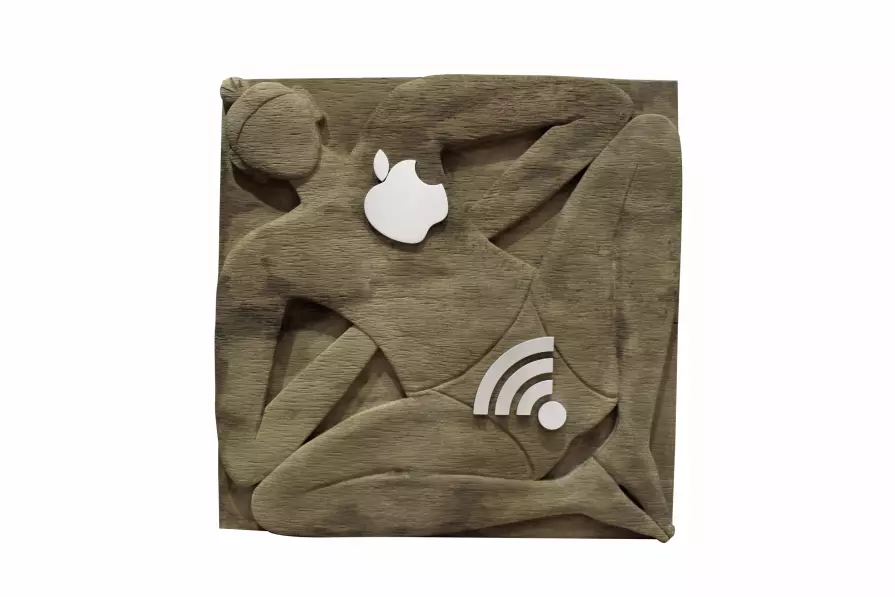
Core
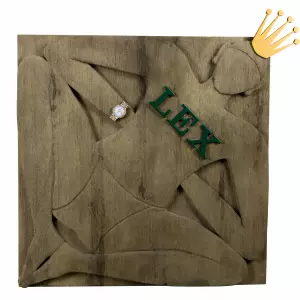
LEX
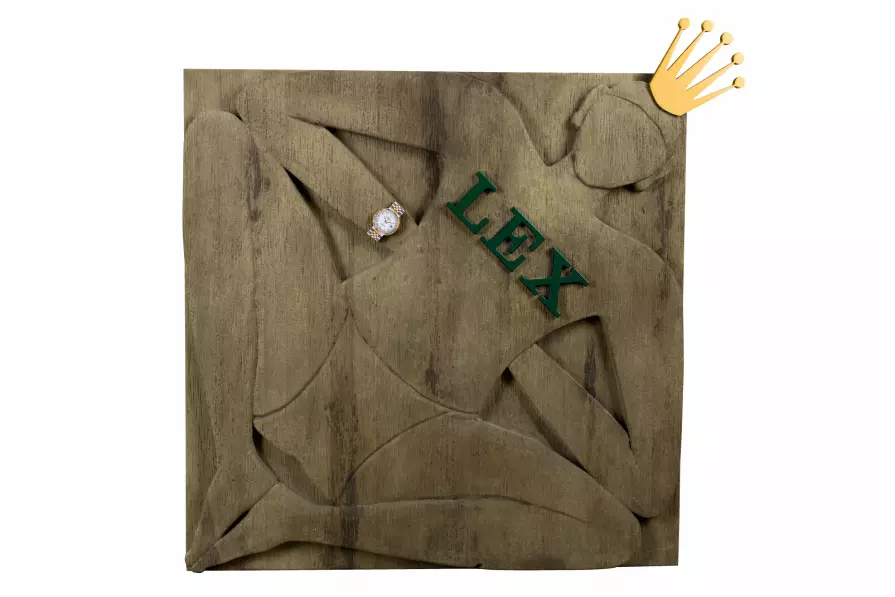
Meaning of a law, its' exictence and integration of our life as huge motive of art. For people who never think about what they can really do and what they are allow to."LEX" written in the center of the work unveil a latin root of "law" word. it's a cornerstone of Western legal system. But there are people who think they are above the law through times, countries and culture. Buddha’s image cut out of wood and modern culture symbols made with shiny aerographic labels. Wood engraving is identical to the primitive technique of ancient artists for centuries. The artificial bright color of new stamped patterns is the first to attract attention thus moving back works and over shading handmade masterpieces just similar to the contemporary behavioral patterns in our society.There is only one real law - the law of human being. We are ought to stay a human in every situation and follow for social agreement, respect freedom, rights and religion of each other. Symbol of the crown in the top in a famous label manner as a sign of parallel between the wealth and moral values, social rules. Made from wood that was kept in Java island to absorb a special atmosphere and energy of that important in Eastern culture place. Series of artworks “Artefacts” is a number of Buddha images carved on wooden panels in a simple woodcarving manner. Such primitive sculptures of the Buddha might have been created by unknown rural masters not only today, but also during all those thousands of years when Buddhism was being established as a world religion. Its main symbol, the Buddha, became an artistic symbol, incorporating the experience of generations and the environment of values expressed in a simplified and understandable image — an artefact of the Eastern culture. In this project, the infallible and imperturbable image of the Buddha has other additional significance. The Buddha is “enriched” with unexpected additions — seemingly inappropriate, provocative symbols of modern cultural and information world of consumerism in the form of shiny aluminum signs: recognizable brands and logos; idols of the fashion industry; fictional characters of the Western society; new attributes of beauty; and the inalienable symbols of social networks, which affect all areas of modern life. These objects are artefacts with new content that have the value of a different type. The symbols of modern times overlap the classic image and slowly integrate into its meaning. This cultural diffusion is global; every new generation still carries experience and spiritual wealth of ancestors, but constant social and global phenomena force them to adapt and find their own path of development, evolve mentally rather than physically and change their perception of the world. The change of consciousness and mindset pushes us to seek the best balance between the traditional spiritual values and cultural symbols of postmodernism. That’s exactly what produces an unexpected and shocking effect. But the artist takes the image of the Buddha as the basis of her artwork and thus determines its dominant value. Yes, visually this image blends into the background but only to become the beginning of other events and ’characters’ that mankind needs today to go to the next stage of evolution. The Buddha is still the guide for moral and spiritual values. The idea of the “Artefacts” project is to combine the two quite contradictory elements of culture — modern Western and ancient Eastern, and to contrast the global phenomena — the consumer society, the cultural and technological dependence of modern civilization and the ethical traditions of the main Eastern religion, the Buddhism. For centuries, the Buddha was a major artefact of human spiritual existence, and now, to remain one, he goes along the path of modernization and evolution incorporating new values, once again proving to us his unwavering importance in our lives and willingness to change in accordance with the requirements of “future society”.

Fashion Guru
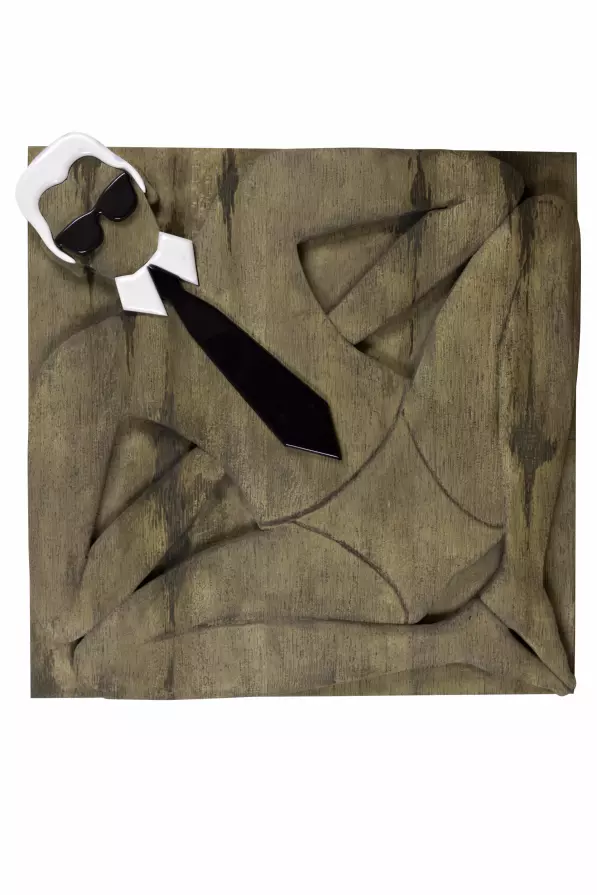
Fashion industry always motivates artist to create new artwork or becomes a body of work for pictures and installations. There are many significant persons in contemporary fashion sphere. Among them is one real icon - Karl Lagerfeld - who made a big investment developing industry. Latest changes in policy of fashion houses and creative directors' positions have made situation very difficult. But Karl Lagerfeld still has strong position and enough ideas to do 10-12 fashion collections per year. The society needs to be lead in every sphere of life. We choose a government, we choose a religion, we choose an idol in fashion who we can trust in style and follow to. This work shows people dependence of trendsetters. Years ago we had a spirit guru to make our life better and now we need a fashion guru for this case. It shows us a value changes in the society with time passed. All symbolic meanings and elements reflect image of main hero in fashion industry and show his very trendy look caught in memory. Series of artworks “Artefacts” is a number of Buddha images carved on wooden panels in a simple woodcarving manner. Such primitive sculptures of the Buddha might have been created by unknown rural masters not only today, but also during all those thousands of years when Buddhism was being established as a world religion. Its main symbol, the Buddha, became an artistic symbol, incorporating the experience of generations and the environment of values expressed in a simplified and understandable image — an artefact of the Eastern culture. In this project, the infallible and imperturbable image of the Buddha has other additional significance. The Buddha is “enriched” with unexpected additions — seemingly inappropriate, provocative symbols of modern cultural and information world of consumerism in the form of shiny aluminum signs: recognizable brands and logos; idols of the fashion industry; fictional characters of the Western society; new attributes of beauty; and the inalienable symbols of social networks, which affect all areas of modern life. These objects are artefacts with new content that have the value of a different type. The symbols of modern times overlap the classic image and slowly integrate into its meaning. This cultural diffusion is global; every new generation still carries experience and spiritual wealth of ancestors, but constant social and global phenomena force them to adapt and find their own path of development, evolve mentally rather than physically and change their perception of the world. The change of consciousness and mindset pushes us to seek the best balance between the traditional spiritual values and cultural symbols of postmodernism. That’s exactly what produces an unexpected and shocking effect. But the artist takes the image of the Buddha as the basis of her artwork and thus determines its dominant value. Yes, visually this image blends into the background but only to become the beginning of other events and ’characters’ that mankind needs today to go to the next stage of evolution. The Buddha is still the guide for moral and spiritual values. The idea of the “Artefacts” project is to combine the two quite contradictory elements of culture — modern Western and ancient Eastern, and to contrast the global phenomena — the consumer society, the cultural and technological dependence of modern civilization and the ethical traditions of the main Eastern religion, the Buddhism. For centuries, the Buddha was a major artefact of human spiritual existence, and now, to remain one, he goes along the path of modernization and evolution incorporating new values, once again proving to us his unwavering importance in our lives and willingness to change in accordance with the requirements of “future society”.
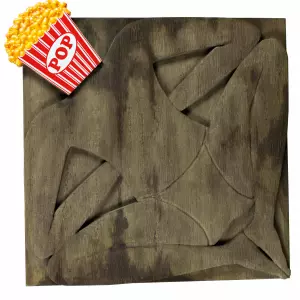
Just Pop
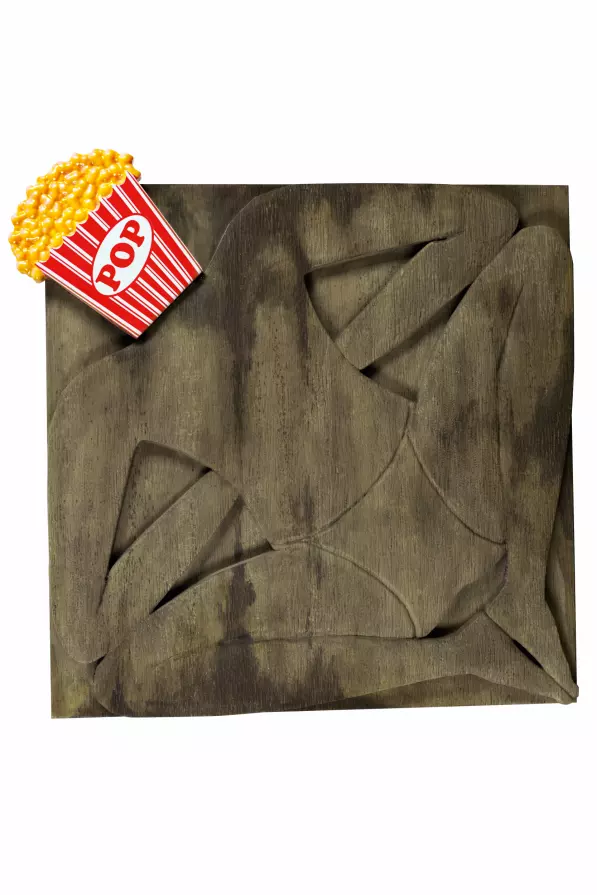
'Just Pop' is an art piece made for Artefacts project. Series of artworks “Artefacts” is a number of Buddha images carved on wooden panels in a simple woodcarving manner. Such primitive sculptures of the Buddha might have been created by unknown rural masters not only today, but also during all those thousands of years when Buddhism was being established as a world religion. Its main symbol, the Buddha, became an artistic symbol, incorporating the experience of generations and the environment of values expressed in a simplified and understandable image — an artefact of the Eastern culture. In this project, the infallible and imperturbable image of the Buddha has other additional significance. The Buddha is “enriched” with unexpected additions — seemingly inappropriate, provocative symbols of modern cultural and information world of consumerism in the form of shiny aluminum signs: recognizable brands and logos; idols of the fashion industry; fictional characters of the Western society; new attributes of beauty; and the inalienable symbols of social networks, which affect all areas of modern life. These objects are artefacts with new content that have the value of a different type. The symbols of modern times overlap the classic image and slowly integrate into its meaning. This cultural diffusion is global; every new generation still carries experience and spiritual wealth of ancestors, but constant social and global phenomena force them to adapt and find their own path of development, evolve mentally rather than physically and change their perception of the world. The change of consciousness and mindset pushes us to seek the best balance between the traditional spiritual values and cultural symbols of postmodernism. That’s exactly what produces an unexpected and shocking effect. But the artist takes the image of the Buddha as the basis of her artwork and thus determines its dominant value. Yes, visually this image blends into the background but only to become the beginning of other events and ’characters’ that mankind needs today to go to the next stage of evolution. The Buddha is still the guide for moral and spiritual values. The idea of the “Artefacts” project is to combine the two quite contradictory elements of culture — modern Western and ancient Eastern, and to contrast the global phenomena — the consumer society, the cultural and technological dependence of modern civilization and the ethical traditions of the main Eastern religion, the Buddhism. For centuries, the Buddha was a major artefact of human spiritual existence, and now, to remain one, he goes along the path of modernization and evolution incorporating new values, once again proving to us his unwavering importance in our lives and willingness to change in accordance with the requirements of “future society”.

Fine Gold

Fine Gold is an art piece made for Artefacts project. Series of artworks “Artefacts” is a number of Buddha images carved on wooden panels in a simple woodcarving manner. Such primitive sculptures of the Buddha might have been created by unknown rural masters not only today, but also during all those thousands of years when Buddhism was being established as a world religion. Its main symbol, the Buddha, became an artistic symbol, incorporating the experience of generations and the environment of values expressed in a simplified and understandable image — an artefact of the Eastern culture. In this project, the infallible and imperturbable image of the Buddha has other additional significance. The Buddha is “enriched” with unexpected additions — seemingly inappropriate, provocative symbols of modern cultural and information world of consumerism in the form of shiny aluminum signs: recognizable brands and logos; idols of the fashion industry; fictional characters of the Western society; new attributes of beauty; and the inalienable symbols of social networks, which affect all areas of modern life. These objects are artefacts with new content that have the value of a different type. The symbols of modern times overlap the classic image and slowly integrate into its meaning. This cultural diffusion is global; every new generation still carries experience and spiritual wealth of ancestors, but constant social and global phenomena force them to adapt and find their own path of development, evolve mentally rather than physically and change their perception of the world. The change of consciousness and mindset pushes us to seek the best balance between the traditional spiritual values and cultural symbols of postmodernism. That’s exactly what produces an unexpected and shocking effect. But the artist takes the image of the Buddha as the basis of her artwork and thus determines its dominant value. Yes, visually this image blends into the background but only to become the beginning of other events and ’characters’ that mankind needs today to go to the next stage of evolution. The Buddha is still the guide for moral and spiritual values. The idea of the “Artefacts” project is to combine the two quite contradictory elements of culture — modern Western and ancient Eastern, and to contrast the global phenomena — the consumer society, the cultural and technological dependence of modern civilization and the ethical traditions of the main Eastern religion, the Buddhism. For centuries, the Buddha was a major artefact of human spiritual existence, and now, to remain one, he goes along the path of modernization and evolution incorporating new values, once again proving to us his unwavering importance in our lives and willingness to change in accordance with the requirements of “future society”.

Creeper

Creeper is an art piece made for Artefacts project. Series of artworks “Artefacts” is a number of Buddha images carved on wooden panels in a simple woodcarving manner. Such primitive sculptures of the Buddha might have been created by unknown rural masters not only today, but also during all those thousands of years when Buddhism was being established as a world religion. Its main symbol, the Buddha, became an artistic symbol, incorporating the experience of generations and the environment of values expressed in a simplified and understandable image — an artefact of the Eastern culture. In this project, the infallible and imperturbable image of the Buddha has other additional significance. The Buddha is “enriched” with unexpected additions — seemingly inappropriate, provocative symbols of modern cultural and information world of consumerism in the form of shiny aluminum signs: recognizable brands and logos; idols of the fashion industry; fictional characters of the Western society; new attributes of beauty; and the inalienable symbols of social networks, which affect all areas of modern life. These objects are artefacts with new content that have the value of a different type. The symbols of modern times overlap the classic image and slowly integrate into its meaning. This cultural diffusion is global; every new generation still carries experience and spiritual wealth of ancestors, but constant social and global phenomena force them to adapt and find their own path of development, evolve mentally rather than physically and change their perception of the world. The change of consciousness and mindset pushes us to seek the best balance between the traditional spiritual values and cultural symbols of postmodernism. That’s exactly what produces an unexpected and shocking effect. But the artist takes the image of the Buddha as the basis of her artwork and thus determines its dominant value. Yes, visually this image blends into the background but only to become the beginning of other events and ’characters’ that mankind needs today to go to the next stage of evolution. The Buddha is still the guide for moral and spiritual values. The idea of the “Artefacts” project is to combine the two quite contradictory elements of culture — modern Western and ancient Eastern, and to contrast the global phenomena — the consumer society, the cultural and technological dependence of modern civilization and the ethical traditions of the main Eastern religion, the Buddhism. For centuries, the Buddha was a major artefact of human spiritual existence, and now, to remain one, he goes along the path of modernization and evolution incorporating new values, once again proving to us his unwavering importance in our lives and willingness to change in accordance with the requirements of “future society”.
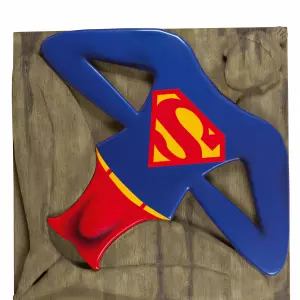
Super Buddha
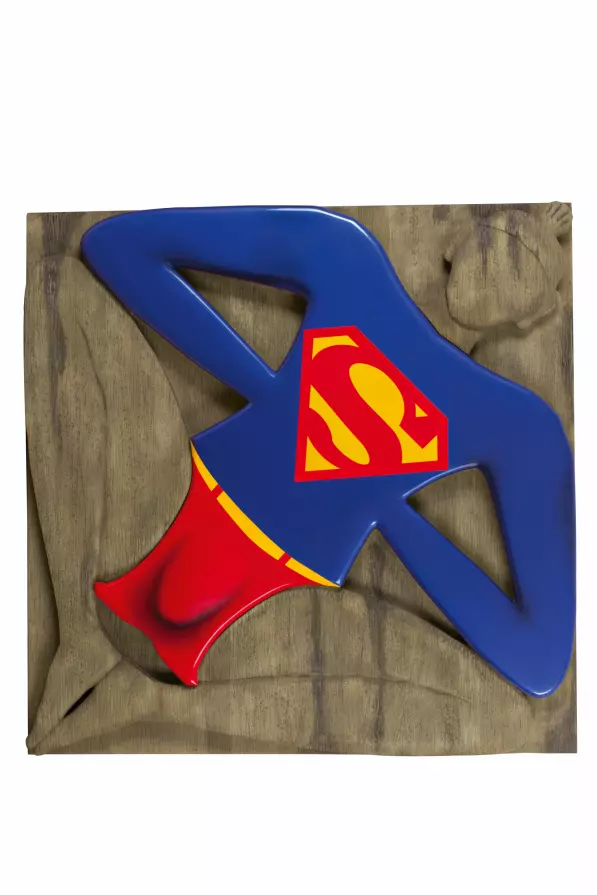
'Super Buddha' is an art piece made for Artefacts project. Series of artworks “Artefacts” is a number of Buddha images carved on wooden panels in a simple woodcarving manner. Such primitive sculptures of the Buddha might have been created by unknown rural masters not only today, but also during all those thousands of years when Buddhism was being established as a world religion. Its main symbol, the Buddha, became an artistic symbol, incorporating the experience of generations and the environment of values expressed in a simplified and understandable image — an artefact of the Eastern culture. In this project, the infallible and imperturbable image of the Buddha has other additional significance. The Buddha is “enriched” with unexpected additions — seemingly inappropriate, provocative symbols of modern cultural and information world of consumerism in the form of shiny aluminum signs: recognizable brands and logos; idols of the fashion industry; fictional characters of the Western society; new attributes of beauty; and the inalienable symbols of social networks, which affect all areas of modern life. These objects are artefacts with new content that have the value of a different type. The symbols of modern times overlap the classic image and slowly integrate into its meaning. This cultural diffusion is global; every new generation still carries experience and spiritual wealth of ancestors, but constant social and global phenomena force them to adapt and find their own path of development, evolve mentally rather than physically and change their perception of the world. The change of consciousness and mindset pushes us to seek the best balance between the traditional spiritual values and cultural symbols of postmodernism. That’s exactly what produces an unexpected and shocking effect. But the artist takes the image of the Buddha as the basis of her artwork and thus determines its dominant value. Yes, visually this image blends into the background but only to become the beginning of other events and ’characters’ that mankind needs today to go to the next stage of evolution. The Buddha is still the guide for moral and spiritual values. The idea of the “Artefacts” project is to combine the two quite contradictory elements of culture — modern Western and ancient Eastern, and to contrast the global phenomena — the consumer society, the cultural and technological dependence of modern civilization and the ethical traditions of the main Eastern religion, the Buddhism. For centuries, the Buddha was a major artefact of human spiritual existence, and now, to remain one, he goes along the path of modernization and evolution incorporating new values, once again proving to us his unwavering importance in our lives and willingness to change in accordance with the requirements of “future society”.

Candy Man
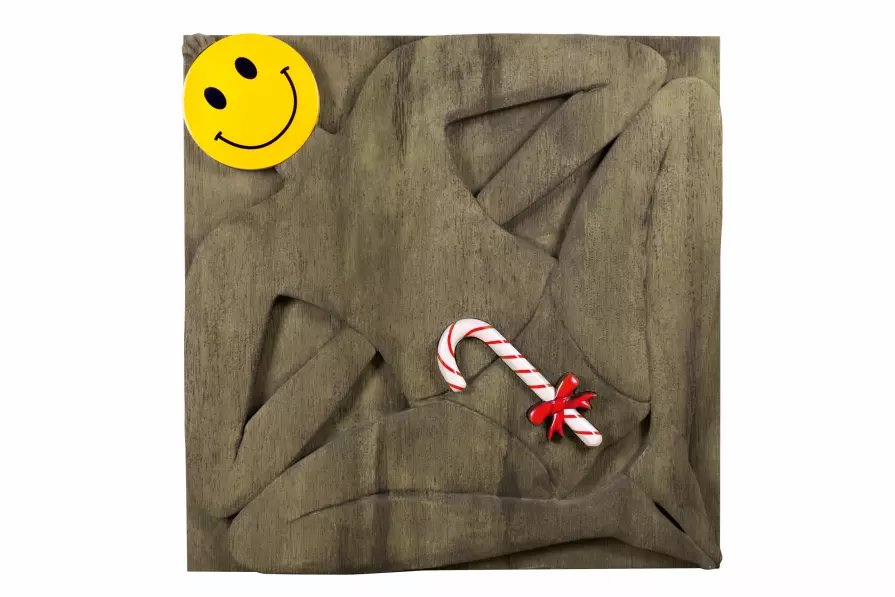
'Candy Man' is an art piece made for Artefacts project. Series of artworks “Artefacts” is a number of Buddha images carved on wooden panels in a simple woodcarving manner. Such primitive sculptures of the Buddha might have been created by unknown rural masters not only today, but also during all those thousands of years when Buddhism was being established as a world religion. Its main symbol, the Buddha, became an artistic symbol, incorporating the experience of generations and the environment of values expressed in a simplified and understandable image — an artefact of the Eastern culture. In this project, the infallible and imperturbable image of the Buddha has other additional significance. The Buddha is “enriched” with unexpected additions — seemingly inappropriate, provocative symbols of modern cultural and information world of consumerism in the form of shiny aluminum signs: recognizable brands and logos; idols of the fashion industry; fictional characters of the Western society; new attributes of beauty; and the inalienable symbols of social networks, which affect all areas of modern life. These objects are artefacts with new content that have the value of a different type. The symbols of modern times overlap the classic image and slowly integrate into its meaning. This cultural diffusion is global; every new generation still carries experience and spiritual wealth of ancestors, but constant social and global phenomena force them to adapt and find their own path of development, evolve mentally rather than physically and change their perception of the world. The change of consciousness and mindset pushes us to seek the best balance between the traditional spiritual values and cultural symbols of postmodernism. That’s exactly what produces an unexpected and shocking effect. But the artist takes the image of the Buddha as the basis of her artwork and thus determines its dominant value. Yes, visually this image blends into the background but only to become the beginning of other events and ’characters’ that mankind needs today to go to the next stage of evolution. The Buddha is still the guide for moral and spiritual values. The idea of the “Artefacts” project is to combine the two quite contradictory elements of culture — modern Western and ancient Eastern, and to contrast the global phenomena — the consumer society, the cultural and technological dependence of modern civilization and the ethical traditions of the main Eastern religion, the Buddhism. For centuries, the Buddha was a major artefact of human spiritual existence, and now, to remain one, he goes along the path of modernization and evolution incorporating new values, once again proving to us his unwavering importance in our lives and willingness to change in accordance with the requirements of “future society”.


'Facebook' is an art piece made for Artefacts project. Series of artworks “Artefacts” is a number of Buddha images carved on wooden panels in a simple woodcarving manner. Such primitive sculptures of the Buddha might have been created by unknown rural masters not only today, but also during all those thousands of years when Buddhism was being established as a world religion. Its main symbol, the Buddha, became an artistic symbol, incorporating the experience of generations and the environment of values expressed in a simplified and understandable image — an artefact of the Eastern culture. In this project, the infallible and imperturbable image of the Buddha has other additional significance. The Buddha is “enriched” with unexpected additions — seemingly inappropriate, provocative symbols of modern cultural and information world of consumerism in the form of shiny aluminum signs: recognizable brands and logos; idols of the fashion industry; fictional characters of the Western society; new attributes of beauty; and the inalienable symbols of social networks, which affect all areas of modern life. These objects are artefacts with new content that have the value of a different type. The symbols of modern times overlap the classic image and slowly integrate into its meaning. This cultural diffusion is global; every new generation still carries experience and spiritual wealth of ancestors, but constant social and global phenomena force them to adapt and find their own path of development, evolve mentally rather than physically and change their perception of the world. The change of consciousness and mindset pushes us to seek the best balance between the traditional spiritual values and cultural symbols of postmodernism. That’s exactly what produces an unexpected and shocking effect. But the artist takes the image of the Buddha as the basis of her artwork and thus determines its dominant value. Yes, visually this image blends into the background but only to become the beginning of other events and ’characters’ that mankind needs today to go to the next stage of evolution. The Buddha is still the guide for moral and spiritual values. The idea of the “Artefacts” project is to combine the two quite contradictory elements of culture — modern Western and ancient Eastern, and to contrast the global phenomena — the consumer society, the cultural and technological dependence of modern civilization and the ethical traditions of the main Eastern religion, the Buddhism. For centuries, the Buddha was a major artefact of human spiritual existence, and now, to remain one, he goes along the path of modernization and evolution incorporating new values, once again proving to us his unwavering importance in our lives and willingness to change in accordance with the requirements of “future society”.
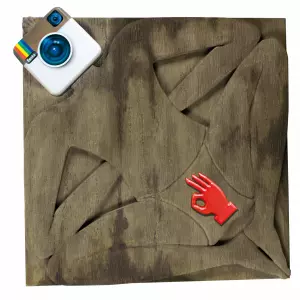
Follow Me
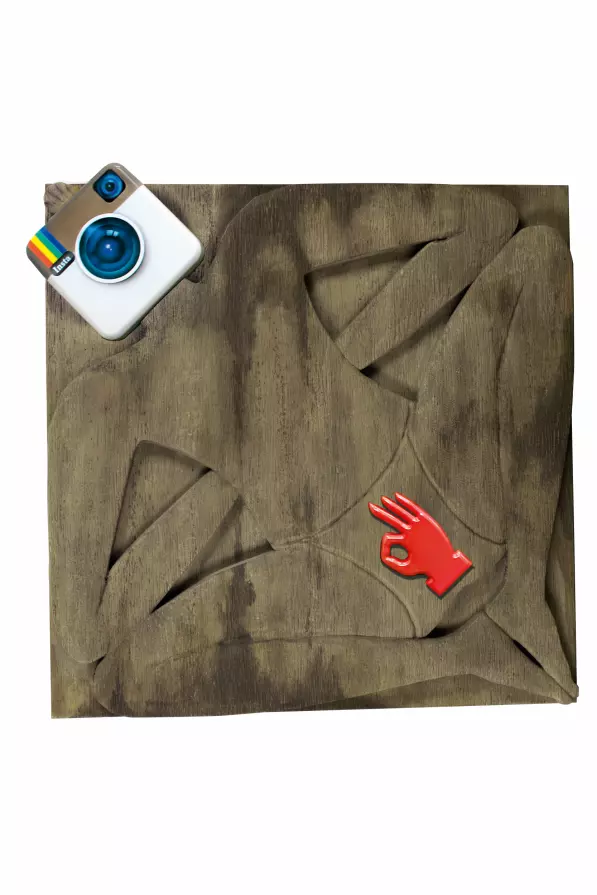
The Buddha became an artistic symbol, incorporating the experience of generations and the environment of values expressed in a simplified and understandable image — an artefact of the Eastern culture. Depth of insight accompanied by laconism in expression is to be evident to anyone who sees the world through mobile device or judges somebody by profile in social networks. A set of new factors made a shift in order of traditional values that has transformed our society into a kind of Vanity Fair. Culture and religion are not now basic dominants that used to determine our lives. Moreover, they are often subject to changes and ought to adjust themselves to modern realities. Buddha’s image cut out of wood and modern culture symbols made with shiny aerographic labels. Wood engraving is identical to the primitive technique of ancient artists for centuries. The artificial bright color of new stamped patterns is the first to attract attention thus moving back works and over shading handmade masterpieces just similar to the contemporary behavioral patterns in our society. Irrational world creates irrational views and priorities, virtual reality outweighs real life, visual merits have became a leading ones. Traditional values are ousted from real life and substituted with their prototypes playing certain roles with a slogan «Follow me». But the picture yet has another message to persons who are worried only with their appearance.The choice of material is made not by chance, texture is even more important than an image. Jean Baudrillard studied the phenomenon of consumption separated from nature and that is the truth. The idea of the piece “Follow me” was the first in the series of works “Artefacts” and became dominant for the Artist. It comprises the actuality of the principal problem and implications from other works.
Other works

Genie In The Can
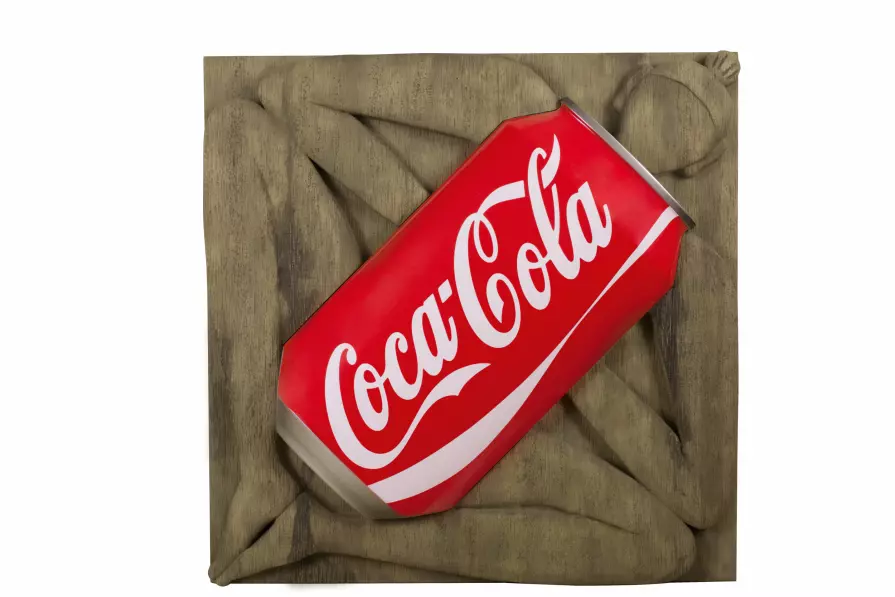
'Genie in the can' is an art piece made for Artefacts project. Series of artworks “Artefacts” is a number of Buddha images carved on wooden panels in a simple woodcarving manner. Such primitive sculptures of the Buddha might have been created by unknown rural masters not only today, but also during all those thousands of years when Buddhism was being established as a world religion. Its main symbol, the Buddha, became an artistic symbol, incorporating the experience of generations and the environment of values expressed in a simplified and understandable image — an artefact of the Eastern culture. In this project, the infallible and imperturbable image of the Buddha has other additional significance. The Buddha is “enriched” with unexpected additions — seemingly inappropriate, provocative symbols of modern cultural and information world of consumerism in the form of shiny aluminum signs: recognizable brands and logos; idols of the fashion industry; fictional characters of the Western society; new attributes of beauty; and the inalienable symbols of social networks, which affect all areas of modern life. These objects are artefacts with new content that have the value of a different type. The symbols of modern times overlap the classic image and slowly integrate into its meaning. This cultural diffusion is global; every new generation still carries experience and spiritual wealth of ancestors, but constant social and global phenomena force them to adapt and find their own path of development, evolve mentally rather than physically and change their perception of the world. The change of consciousness and mindset pushes us to seek the best balance between the traditional spiritual values and cultural symbols of postmodernism. That’s exactly what produces an unexpected and shocking effect. But the artist takes the image of the Buddha as the basis of her artwork and thus determines its dominant value. Yes, visually this image blends into the background but only to become the beginning of other events and ’characters’ that mankind needs today to go to the next stage of evolution. The Buddha is still the guide for moral and spiritual values. The idea of the “Artefacts” project is to combine the two quite contradictory elements of culture — modern Western and ancient Eastern, and to contrast the global phenomena — the consumer society, the cultural and technological dependence of modern civilization and the ethical traditions of the main Eastern religion, the Buddhism. For centuries, the Buddha was a major artefact of human spiritual existence, and now, to remain one, he goes along the path of modernization and evolution incorporating new values, once again proving to us his unwavering importance in our lives and willingness to change in accordance with the requirements of “future society”.
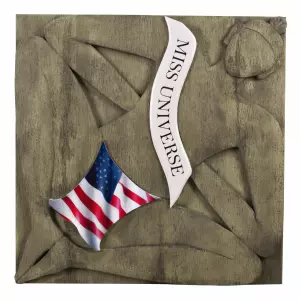
Miss Universe
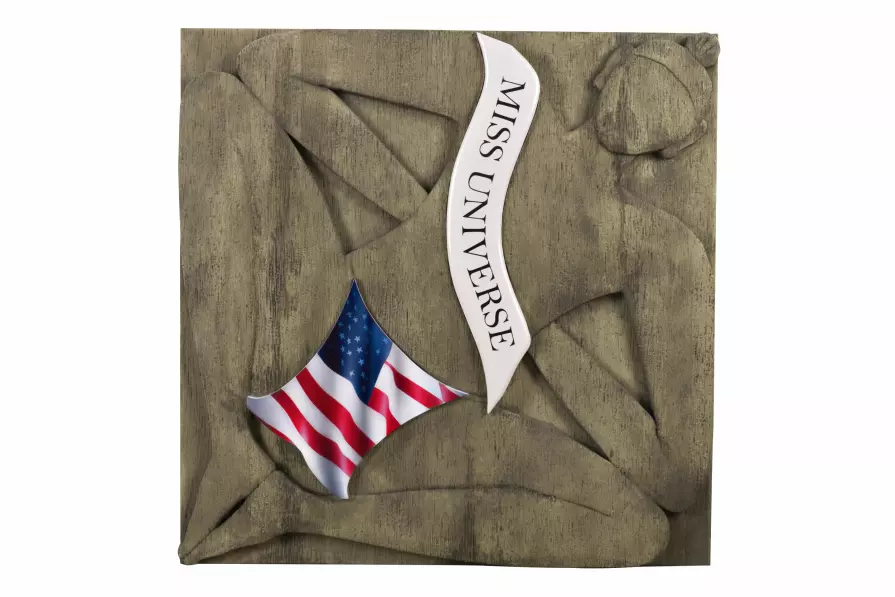
The art piece 'Miss Universe' was inspired by an idea of confident woman who has a power to change the world. But actually her influence is very small and has a local meaning. United States of America think that they have a great power to change the world and a special right to affect on another governments all over the globe. Deteriorating politic, economic and social situations in the world made by main guarantor of financial stability and humanitarian values promoter show there is no more such power. USA have took these roles by itself and fall its own mission. Too much self-confidence never leads to success. All those Miss Universe trying to change the world and think they have enough strength and power to achieve this goal alone just by saying wise words standing before the camera and walking in bikini. But everybody knows it false. The world process can't be changing to better way because of beautiful picture and loud declares. The same strategy have US that's why its flag replaces bikini. Now we all need time to rethink what we can really say and do. Series of artworks “Artefacts” is a number of Buddha images carved on wooden panels in a simple woodcarving manner. Such primitive sculptures of the Buddha might have been created by unknown rural masters not only today, but also during all those thousands of years when Buddhism was being established as a world religion. Its main symbol, the Buddha, became an artistic symbol, incorporating the experience of generations and the environment of values expressed in a simplified and understandable image — an artefact of the Eastern culture. In this project, the infallible and imperturbable image of the Buddha has other additional significance. The Buddha is “enriched” with unexpected additions — seemingly inappropriate, provocative symbols of modern cultural and information world of consumerism in the form of shiny aluminum signs: recognizable brands and logos; idols of the fashion industry; fictional characters of the Western society; new attributes of beauty; and the inalienable symbols of social networks, which affect all areas of modern life. These objects are artefacts with new content that have the value of a different type. The symbols of modern times overlap the classic image and slowly integrate into its meaning. This cultural diffusion is global; every new generation still carries experience and spiritual wealth of ancestors, but constant social and global phenomena force them to adapt and find their own path of development, evolve mentally rather than physically and change their perception of the world. The change of consciousness and mindset pushes us to seek the best balance between the traditional spiritual values and cultural symbols of postmodernism. That’s exactly what produces an unexpected and shocking effect. But the artist takes the image of the Buddha as the basis of her artwork and thus determines its dominant value. Yes, visually this image blends into the background but only to become the beginning of other events and ’characters’ that mankind needs today to go to the next stage of evolution. The Buddha is still the guide for moral and spiritual values. The idea of the “Artefacts” project is to combine the two quite contradictory elements of culture — modern Western and ancient Eastern, and to contrast the global phenomena — the consumer society, the cultural and technological dependence of modern civilization and the ethical traditions of the main Eastern religion, the Buddhism. For centuries, the Buddha was a major artefact of human spiritual existence, and now, to remain one, he goes along the path of modernization and evolution incorporating new values, once again proving to us his unwavering importance in our lives and willingness to change in accordance with the requirements of “future society”.
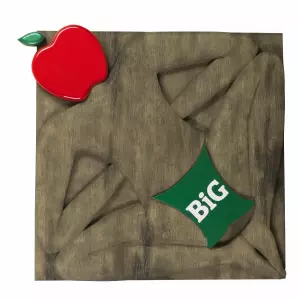
Big Apple

'Big Apple' is an art piece made for the Artefacts project. Series of artworks “Artefacts” is a number of Buddha images carved on wooden panels in a simple woodcarving manner. Such primitive sculptures of the Buddha might have been created by unknown rural masters not only today, but also during all those thousands of years when Buddhism was being established as a world religion. Its main symbol, the Buddha, became an artistic symbol, incorporating the experience of generations and the environment of values expressed in a simplified and understandable image — an artefact of the Eastern culture. In this project, the infallible and imperturbable image of the Buddha has other additional significance. The Buddha is “enriched” with unexpected additions — seemingly inappropriate, provocative symbols of modern cultural and information world of consumerism in the form of shiny aluminum signs: recognizable brands and logos; idols of the fashion industry; fictional characters of the Western society; new attributes of beauty; and the inalienable symbols of social networks, which affect all areas of modern life. These objects are artefacts with new content that have the value of a different type. The symbols of modern times overlap the classic image and slowly integrate into its meaning. This cultural diffusion is global; every new generation still carries experience and spiritual wealth of ancestors, but constant social and global phenomena force them to adapt and find their own path of development, evolve mentally rather than physically and change their perception of the world. The change of consciousness and mindset pushes us to seek the best balance between the traditional spiritual values and cultural symbols of postmodernism. That’s exactly what produces an unexpected and shocking effect. But the artist takes the image of the Buddha as the basis of her artwork and thus determines its dominant value. Yes, visually this image blends into the background but only to become the beginning of other events and ’characters’ that mankind needs today to go to the next stage of evolution. The Buddha is still the guide for moral and spiritual values. The idea of the “Artefacts” project is to combine the two quite contradictory elements of culture — modern Western and ancient Eastern, and to contrast the global phenomena — the consumer society, the cultural and technological dependence of modern civilization and the ethical traditions of the main Eastern religion, the Buddhism. For centuries, the Buddha was a major artefact of human spiritual existence, and now, to remain one, he goes along the path of modernization and evolution incorporating new values, once again proving to us his unwavering importance in our lives and willingness to change in accordance with the requirements of “future society”.
Apple Beat
Series of artworks “Artefacts” is a number of Buddha images carved on wooden panels in a simple woodcarving manner. Such primitive sculptures of the Buddha might have been created by unknown rural masters not only today, but also during all those thousands of years when Buddhism was being established as a world religion. Its main symbol, the Buddha, became an artistic symbol, incorporating the experience of generations and the environment of values expressed in a simplified and understandable image — an artefact of the Eastern culture.
In this project, the infallible and imperturbable image of the Buddha has other additional significance. The Buddha is “enriched” with unexpected additions — seemingly inappropriate, provocative symbols of modern cultural and information world of consumerism in the form of shiny aluminum signs: recognizable brands and logos; idols of the fashion industry; fictional characters of the Western society; new attributes of beauty; and the inalienable symbols of social networks, which affect all areas of modern life. These objects are artefacts with new content that have the value of a different type. The symbols of modern times overlap the classic image and slowly integrate into its meaning. This cultural diffusion is global; every new generation still carries experience and spiritual wealth of ancestors, but constant social and global phenomena force them to adapt and find their own path of development, evolve mentally rather than physically and change their perception of the world. The change of consciousness and mindset pushes us to seek the best balance between the traditional spiritual values and cultural symbols of postmodernism.
That’s exactly what produces an unexpected and shocking effect. But the artist takes the image of the Buddha as the basis of her artwork and thus determines its dominant value. Yes, visually this image blends into the background but only to become the beginning of other events and ’characters’ that mankind needs today to go to the next stage of evolution. The Buddha is still the guide for moral and spiritual values.
The idea of the “Artefacts” project is to combine the two quite contradictory elements of culture — modern Western and ancient Eastern, and to contrast the global phenomena — the consumer society, the cultural and technological dependence of modern civilization and the ethical traditions of the main Eastern religion, the Buddhism. For centuries, the Buddha was a major artefact of human spiritual existence, and now, to remain one, he goes along the path of modernization and evolution incorporating new values, once again proving to us his unwavering importance in our lives and willingness to change in accordance with the requirements of “future society”.
 Share / Save
Share / Save














Comments 0
Say something